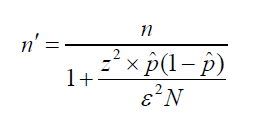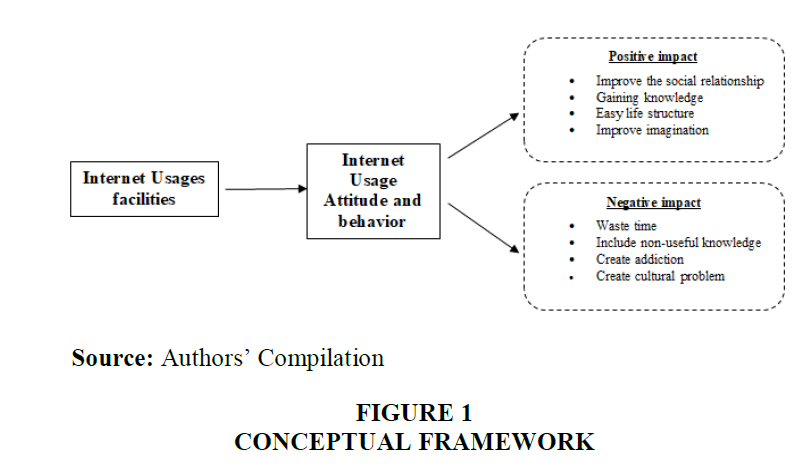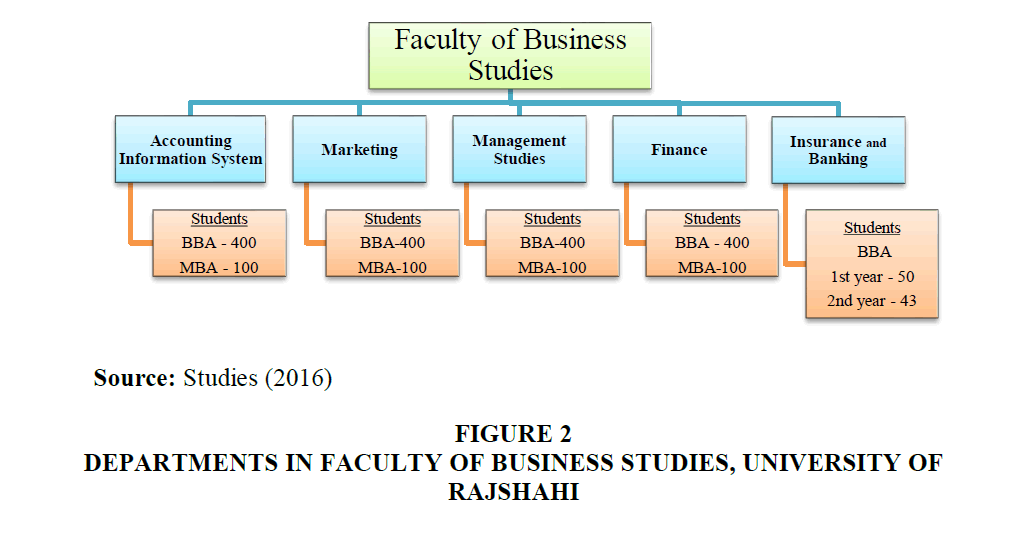Research Article: 2020 Vol: 19 Issue: 1
Business Students Attitude towards Internet Usage: A Strategic Analysis on the Students of University of Rajshahi, Bangladesh
Sabrin Nahar, Shah Makhdum Management University
K. B. M. Rajibul Hasan, Agrani Bank Limited
Tamanna Sharmin Chowdhury, Daffodil International University
Sunjida Khan, Daffodil International University
Nurul Mohammad Zayed, Daffodil International University
Abstract
Internet use is very essential for the students because it serves the students as a teacher. Internet provides fast knowledge and information about the subject to the students. However, the attitude of students is not same for internet use. Different students attitude are different for internet usages. The purpose of this study is to evaluate the attitudes of students of Business Faculty at the University of Rajshahi of towards the Internet specifically how they access the Internet and how frequently they use the Internet in the university. The researcher selected 419 sample size randomly for maintaining the standard of the research and ensuring authenticity. The researcher used factor analysis for this study to analysis the key factor that influences the students for internet usage. The researchers find out that there are three most influential factors that Internet provides such as – easy life, Internet is the fast way to reach knowledge, Internet create close relationship among social entities. This study suggests that the University should improve their ICT framework and create more opportunities of free Internet access to students within the university.
Keywords
Internet Access, Student’s Attitude, Internet Facilities, Factor Analysis, University of Rajshahi.
Introduction
According to Global Digital Report half of population of Bangladesh uses internet now. In 2017, 80 million people used internet and Bangladesh ranked 5 in internet users in Asia (Social, 2018). Therefore, internet directly effects on behavior and ideas of people. Now-a-days internet has huge impact on higher education due to innovate new teaching strategies and new ideas development. In Bangladesh 90.20% students use internet for their educational purpose (Siyad, 2018).
In the learning process educator include technology for improving learning and developing student’s qualities to cope with the 21st century workplace (Slavin, 2019). Globally, internet uses in the learning process in the higher education and it’s a functional tool for connecting with each other. Students use computers for accomplishing large number of academic tasks (Eslami & Ahmadi, 2019). They prepare their assignments, study notes by the help of specialized multimedia. However, this study investigated that which factors influence the attitude of the Business Faculty students regarding internet use.
Literature Review And Conceptual Framework
Students browse internet for searching their educational materials such as- literature searching, research paper and instruction searching (McKenney & Reeves, 2018). Malik & Mahmood (2009) carried out a study on Punjab University’s students Ib search behavior. The researchers found out that 59.5% of the students used the internet to look the materials for their desires information at home, at university 25%, at each home and university15% and 0.5 % at some different places. 67.5% respondents that mean most of the students used the internet every day; for studies 72.5% of the population used the internet, for training and education 76.5%, for enjoyment 68%, for sports activities 18.5% and for shopping purposes 6%. Google was the most often used search engine (97%) followed with Yahoo’s (seventy two percent) (Purcell et al., 2012). The students faced constraints included slow speed, poor quality, overload of information and inappropriate records.
A survey on the use of Internet services and resources was conducted by Kaur & Manhas (2008) in Haryana states of India and Punjab’s engineering colleges by students and teachers found out that each of the respondents make common use of the internet due to the fact they received access from either university or at home (Lee, 2017). The respondents’ more than 75% use the internet offerings for instructional and research functions. Google and Yahoo are widely used than special search engines (Both et al., 2018). In a survey of an American agricultural university’s students Rhoades et al. (2007) investigate that internet utilization discovered that most of them used internet at their homes and used a search engine when they are on-line. Most of the students tended to specify seeing the internet as proper, smooth to recognize, critical, useful, credible, believable and correct.
The students of university of Nigeria used 81% internet for academic purpose and only 15% used for entertainment purpose (Anunobi, 2006).Sharma, et al. (2006) conduct a survey on medical students in India that found 80% students used internet for getting academic information or research work (Demir & Kutlu, 2018). Most of them used it for getting latest information and maximum students used Google Search Engine. In the Federal University of Technology Ojokoh & Asaolu (2005) found that only 3.4% students are not using internet. In USA African American College students 76% of students used internet for more than three years. At school their access point 49% and at home 47% per day an average two hours for finding school materials and academic purpose.
In Bangladesh Islam (2017) investigates that the habituation rate of Internet and library in University of Rajshahi faculty members. The researcher evaluate that respondents are used 75.80% internet daily basis where library used rate is only 11.29%. Moreover, Munshi et al. (2018) explained in their study that students have positive attitude towards the social networking sites for the purpose of their study. They investigated that social networking sites helped the students of University of Rajshahi in their educational field by building their good relationship with friends, educators, etc. The students can study collaboratively by the help of social media networking (Heath, 2018). Roknuzzaman (2006) evaluated in his study that half of the responsible authority of various sector of the public University of Bangladesh is not satisfied with the existing facilities of internet.
Methodology
This study used quantitative survey methods for data analysis. Data are collected from primary sources. Researchers conduct a survey at the premises of business faculty in University of Rajshahi.
Sample Design
This study used random sampling techniques. The population number 2093(approximately) that indicates the students of business faculty in University of Rajshahi. For research population and sampling design, this study followed the following structure (Figure 1).
The formula of sample size design is

By using this formula sample size is 325 for 2093 population size. But for equal distribution the researcher considered a round figure of sample size. From this population, the researcher selects sample size 419by using random method approximately that is 20% of our total population.
Figure 2 represents that the total students of business faculty of University of Rajshahi. Among this in Accounting Information System Department, have 500 where 400 students in BBA program in 4 year and 100 students for MBA program for one year. In Marketing Department the total students 500 within this in BBA program is 400 and 100 in MBA. In Management Studies Department total students are 500 within this 400 students are in BBA program and 100 students in MBA program. In Finance Department the total students is 500 that includes 400 for BBA program and 100 in MBA program. Moreover, Insurance and Banking is the new department that only start the BBA program that has 93 students total including 50 in first year and 43 in second years.
Data Collection Method
The researchers used questionnaire survey method for data collection. The questionnaire was divided into two parts. Section A was content demographic questions and Section B was content specific questions related to research topic. For Section B researchers used 5 point Likert Scale questionnaires.
Results & Discussion
This study provided a significant role for the research work. Research findings provided information that the researcher discover, or opinions that they form after doing research.
Descriptive Statistics (Analysis of problem faced by students regarding internet use)
The researcher conducts descriptive analysis Table 1 to investigate the personal factors and what problem students faced regarding internet use. The researcher found that students faced problem regarding internet use such as place of internet use, high cost of internet, little experience of internet use in previous, limited internet facilities provide by university, insufficient technical support by university, lack of training about basic internet skill, lack of privacy.
| Table 1: Computation Of Mean, Medium And Standard Deviation | |||||
| Mean | Median | SD | |||
|---|---|---|---|---|---|
| Internal Factor | Online time & activities | Formal training in using internet | 1.7224 | 2.0000 | 0.44841 |
| Using Smartphone for using internet | 1.2005 | 1.0000 | 0.41356 | ||
| Frequency of internet use | 1.5501 | 1.0000 | 0.93648 | ||
| Family Factor | Computer availability | Computer availability at home/residents | 1.3496 | 1.0000 | 0.49339 |
| Internet facilities at home/resistance | 1.2725 | 1.0000 | 0.46283 | ||
| Community Factor | University environment | Computer internet facilities at University | 1.1028 | 1.0000 | 0.30412 |
| Having University Registration ID | 1.2596 | 1.0000 | 0.45059 | ||
| Assistance in using internet | 2.1774 | 2.0000 | 0.50452 | ||
| Slow internet connection | 1.8123 | 2.0000 | 0.97824 | ||
| Time constant | 2.4859 | 2.0000 | 0.98071 | ||
KMO and Bartlett’s Test (Analysis Influential Factor)
The researcher took 419 sample sizes for this research that help to conclude the factor analysis.
When the KMO is near 1, a factor or factors can probably be extracted, since the opposite pattern is visible. Therefore, KMO “values betIen 0.5 and 0.7 are mediocre, values betIen 0.7 and 0.8 are good, values betIen 0.8 and 0.9 are great and values above 0.9 are superb” (Field, 2009). The KMO value (Table 2) of this dataset falls within 0.7 to 0.8 (KMO=0.763). So KMO values are good in position. The researcher include 16 factors in this analysis among these 13 are less influential because their Eigen values are less than 1 and total cumulative value is 48.453. On the other hand, 3 factors are most influential because their Eigen values more than 1 and the cumulative value is 51.547. The three most influential factors are internet provides easy life, internet is the fast way to reach knowledge, and internet creates close relationship among social entities.
| Table 2: Kmo And Bartlett’s Test | ||
| Kaiser-Meyer-Olkin Measure of Sampling Adequacy | 0.763 | |
| Bartlett’s Test of Sphericity | Approx. Chi-Square | 1110.523 |
| df | 78 | |
| Sig. | 0.000 | |
Source: Estimated.
Conclusions and Recommendations
In this 21st century internet has made on every spare of our life e.g. personal, business, education, industry, etc. (Villa-Real, 2014). For this reason, this study conducted for investigate which factors influence the students regarding internet use. University majority students do not have proper training of internet use and few of them learnt from themselves or their friends (Caplan, 2016). The students of university of Rajshahi have a very positive attitude towards internet usage that is also helped in their study time. Most of the students use the internet for study purpose such as- dictionaries, online databases, online courses and encyclopedias (Simonson& Seepersaud, 2018). The most popular search engine among students is Google and they search study materials by using this. However, the students are dissatisfied with the internet service provision, network system and insufficient computer equipment in the lab. However, by analyzing all the factors the researchers recommend that the University of Rajshahi should develop a clear ICT policy framework and train University community (both students and staff) for advance use of internet (Asongu et al., 2018). University should provide internet facilities in its library, laboratories, and classroom and improve computer accessories and networks system to help the student’s e-learning.
References
- Anunobi, C.V. (2006). Dynamics of Internet Usage: A Case of the Students of the Federal University of Technology Owerri (FUTO) Nigeria.
- Asongu, S.A., Le Roux, S., & Biekpe, N. (2018). Enhancing ICT for environmental sustainability in sub-Saharan Africa.Technological Forecasting and Social Change,127, 209-216.
- Both, T., Lindholm, C., Scheibe, B., & Schulz, T. (2018).U.S. Patent No. 9,880,702. Washington, DC: U.S. Patent and Trademark Office.
- Caplan, S.E. (2006). Relations among loneliness, social anxiety, and problematic Internet use.CyberPsychology & behavior,10(2), 234-242.
- Demir, Y., & Kutlu, M. (2018). Relationships among Internet addiction, academic motivation, academic procrastination and school attachment in adolescents.International Online Journal of Educational Sciences,10(5).
- Eslami, R., & Ahmadi, S. (2019). Investigating the role of educational media on secondary school students’ learning process improvement in Jahrom city.Journal of Humanities Insights,3(01), 13-16.
- Heath, S. (2018).U.S. Patent No. 10,120,877. Washington, DC: U.S. Patent and Trademark Office.
- Islam, N. (2017). Faculty members’ attitudes towards the usage and applications of library and internet resources: A study on university of Rajshahi. Retrieved from http://www.ru.ac.bd/socialsc/wp-content/uploads/sites/69/2018/08/8.-Md.-Nazmul-Islam_Latest_OK-117-134.pdf
- Kaur, A., & Manhas, R. (2008). Use of Internet services and resources in the engineering colleges of Punjab and Haryana (India): A study.The International Information & Library Review,40(1), 10-20.
- Lee, K. (2017). Rethinking the accessibility of online higher education: A historical review.The Internet and Higher Education,33, 15-23.
- Malik, A., & Mahmood, K. (2009). Web search behavior of university students: a case study at University of the Punjab.Webology,6(2).
- McKenney, S., & Reeves, T. C. (2018).Conducting educational design research. Routledge.
- Munshi, S.A., Mostafa, M., & Alam, M. (2018). Uses of social networking sites among postgraduate students at University of Rajshahi, Bangladesh: A study.DESIDOC Journal of Library & Information Technology,38(1).
- Ojokoh, B.A., & Asaolu, M F. (2005). Studies on Internet access and usage by students of the federal university of technology, Akure, Nigeria.African Journal of Library, Archives and Information Science,15(2), 149-153.
- Purcell, K., Rainie, L., & Brenner, J. (2012). Search engine use 2012.
- Roknuzzaman, M. (2006). A survey of Internet access in a large public university in Bangladesh.International Journal of Education and Development using ICT,2(3), 86-105.
- Simonson, M., & Seepersaud, D. J. (2018).Distance education: Definition and glossary of terms. Iap.
- Siyad, A.M. (2018). The role of internet in education in Bangladesh.
- Slavin, R.E. (2019).Educational psychology: Theory and practice.
- Social, W.A. (2018). Global digital report 2018.Eri?im: https://wearesocial. com/blog/2018/01/global-digital-report-2018.
- Studies, B. (2016). Journal of business studies. Journal of Business, 9.
- Villa-Real, A.E.C. (2014).U.S. Patent No. 8,831,677. Washington, DC: U.S. Patent and Trademark Office.

